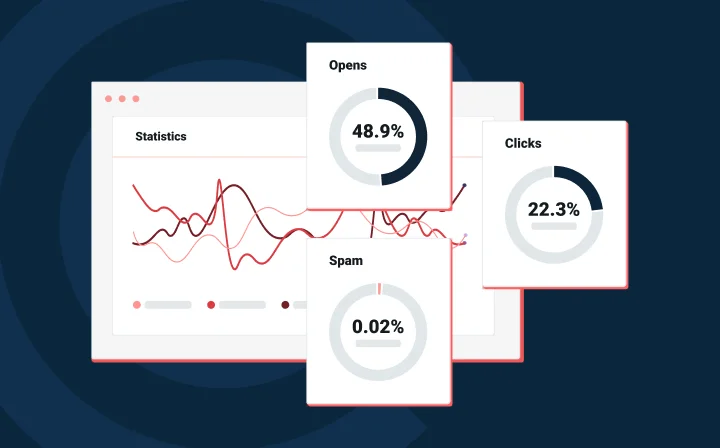Deliverability
The DMARC perspective: Protecting your sending in the age of stricter enforcement

Deliverability

The world of email is undergoing a significant shift. With Google and Yahoo recently increasing enforcement on DMARC, many organizations are having to implement DMARC or risk potential email rejections. We thought it would be a good idea to step back from the Gmail and Yahoo perspective and look at the advantages and reasons for enforcing DMARC from its best advocates.
Let’s start with the basics. Domain-based Message Authentication, Reporting, and Conformance (DMARC) is an email authentication policy and reporting protocol. DMARC authenticates emails and sender identity and proves that messages originate from a legitimate source authorized by your domain.
This helps combat a growing threat – email spoofing. In email spoofing, attackers use a forged sender address to impersonate trusted entities, tricking recipients into clicking malicious links or revealing sensitive information. Here are the basic components of DMARC:
DMARC builds on the authentication capabilities of SPF and DKIM, but goes further and allows senders to tell receiving servers how they want messages that fail authentication to be managed. This is done through selecting policies and there are three possible options.
The p=none tag makes no changes to your existing arrangement – the inbox provider will pass on the message as normal to the recipient.
The p=quarantine tag means sending unqualified mail to the spam folder until you are 100% sure where these emails are originating.
p=reject is the end goal of DMARC adoption, and according to our deliverability experts, it’s where the future of the sender requirements is headed. While quarantining is a good start, you don’t want spoofed emails in your customer’s spam folder forever, you want to eventually take a stronger approach.
Before we dive into the changing DMARC landscape, check out our Email’s Not Dead podcast and listen to our episode with Ash Morin of dmarcian.
Previously, both Google and Yahoo practiced a more relaxed approach to DMARC enforcement. Now with the new sender requirements the gloves are coming off…finally.
“We always wanted a lot of organization. We pushed DMARC adoption when there was a carrot on a stick. Bimi was one of those (carrots), lower premium of cybersecurity insurance, deliverability, security…but when you have names like Google and Yahoo saying, ‘you better do this’ people listen.”

Back in October 2023, Google and Yahoo announced they would be enforcing a few key sender requirements including DMARC adoption for bulk senders. And this is where the first wave of confusion and questions came in from senders. Will I be impacted? Am I a bulk sender?
Are you, or are you not a bulk sender? It sounds like an intense line of witness questioning – and many senders probably resonate with that feeling of being in the hotseat when it comes to these requirements. So, here’s deal, Google defines bulk senders as those who send 5,000 emails within a 24-hour window. Seems straightforward enough.
Yahoo’s definition, however, is intentionally numberless. And it boils down to this, if you think you’re a bulk sender, you’re a bulk sender.
“The number is not 5,000, or 6,000, or 4,000. If you send 4,999 messages, you still have to follow the requirements. If you’re sending the same email to a lot of people, you’re a bulk sender.”

So, here’s the next question. If DMARC is so great at validating sender identity and protecting user’s inboxes, why haven’t senders more widely adopted it? The answer is twofold. It’s both more expensive to implement than authentications like SPF and DMARC, and more technically demanding with different challenges depending on the size of your organization. Here are some of the big challenges:
“For enterprises the challenging Is mostly shadow IT, and by that, I mean business units within the organization have individual needs for services. So, they go out and purchase systems for things like benefits management that sends reports every month. And the service does that by essentially spoofing the organizations domain – in a legitimate way – but that type of mail source can make it harder to achieve DMARC alignment.”

DMARC implementation can be challenging and that’s why providers like dmarcian, and even ESPs like us need to be prepared to talk about DMARC at every level. Implementation challenges will vary depending on your unique organization.
With the challenges identified, how can you ensure a successful DMARC rollout? Here are some best practices to guide you:
“If you don’t have DMARC now, p=none is the first step. And that’s also the minimum being required by Google and Yahoo.”

“A segmentation strategy and segmenting your email stream is very important for a variety of reasons. Security is one of them.”

There are two things you need to do to get through this DMARC process. The first is to make sure you’re sending with best practices like great list hygiene and good segmentation. These deliverability basics will help keep your mail sources organized and optimized which makes it easier to manage DMARC.
The second is to find strong resources so you can troubleshoot when you need to. Resources are going to be your best friend when it comes to navigating DMARC adoption. We’ve linked some great information throughout this post, but you should also check out dmarcian.com and their sender resources tab. They’re the DMARC experts and have assembled everything you need to know.
We’ve been covering the Yoogle changes for a while now, and we’ve got some great information about the requirements. Check out our fireside chat with Google and Yahoo to learn more directly from these mailbox providers.